Contact Us
 Core Technologies Core Technologies
Products overview
 Ambrotose®
Ambrotose®
glyconutrient

Health Solutions:
 Ambrotose AO® Ambrotose AO®
antioxidant
 MannaBears ®
MannaBears ®
with Ambrotose
 PhytoBurst™ PhytoBurst™
nutritional chews
 NutriVerus™ NutriVerus™
multi-blend
 Optimal Support
Optimal Support
Packets
 PhytoMatrix®
PhytoMatrix®
vitamin/mineral
 PLUS™ PLUS™
endocrine health
Targeted Support:
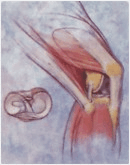 BounceBack® BounceBack®
/anti-inflammatory*
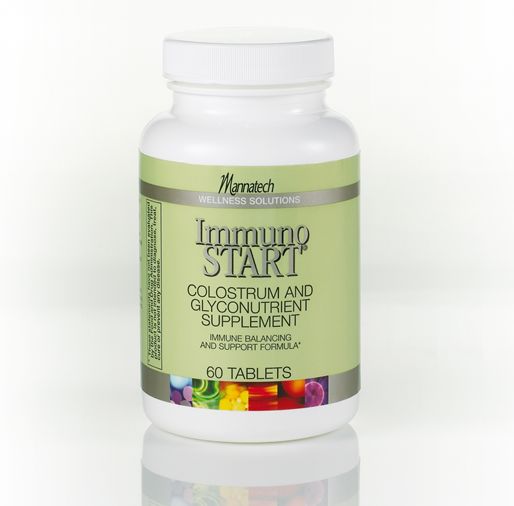 ImmunoStart® ImmunoStart®
immune support
 GI-ProBalance® GI-ProBalance®
probiotic
 MannaCLEANSE™ MannaCLEANSE™
digestive support
 Optimal Support
Optimal Support
Packets
 Omega-3 Omega-3
with D3
 Uth™ Uth™
 new skin care
new skin care
Weight and Fitness:
 OsoLean® OsoLean®
fat loss
 GlycoSlim®
meal GlycoSlim®
meal
replacement drink mix
Glycemic Diet
Glycemic Diet-2
*allow 4 - 6 weeks for optimal results and effects
|
Low Glycemic Diet - Page 2
The diet you can live with for the rest of your life and
get results that last!
Have you ever wondered what causes excess body fat? For many, the cause of excess body fat has more to do with the types of foods they are
eating than with how much they are eating.
Low carbohydrate diets are not necessarily the correct one for you!
That is why so many on a low carbohydrate diet do not succeed in trimming off excess fat without losing lean.
People who follow a diet based on glycemiic-indexing often succeed at getting the fat off and keeping it off.
Glycemic-indexing actually enourages the consumption of carbohydrates but only those that are low or moderately glycemic.
Glycemic-indexing refers to the blood sugar level and insulin response a specific food may cause.
Only foods containing carbohydrates have a glycemic index rating.
Most glycemic references do not mention meat, fowl or fish because they have no carbohydrates and cannot be indexed.
Fat also has no glycemic-index. Just because the word "low fat" is used on products, it does not necessarily mean that it is the best
diet course to follow!
Low-fat diets most likely will not eliminate away excess fat as effectively as low-glycemic diets.
Importantly, while we would probably recommend a low-fat diet for specific health issues, a low-fat diet approach might trigger some serious
health concerns.
Low-calorie, low-carb and low-fat diets fail consistently because they are all very restrictive, and they ignore the actual cause of fat gain.
Becoming fat is not about calories, food fat grams or carbohydrate grams.
Any food that causes your blood sugar to temporarily spike causes an increase in insulin production which will keep you from converting both stored fat and the fat in food into energy.
High-glycemic food calories have a different effect on your body than those from low or moderately glycemic foods.
Generally speaking, low-caloric dieting results in rapid water weight loss (an early false indicator that a diet is "working"), muscle weight loss, minimal fat loss and often even loss of bone density.
Low carb negative effects occur since even zero carbohydrate intake can result in fat gain after the body adjusts itself downward in response to a lack of the healthy carbohydrates it requires daily.
Carbohydrates are also necessary for building and maintaining muscle.
Most high-fiber carbohydrate foods in their natural state are low-glycemic!
Low-glycemic is the healthiest, most effective way to go if you want to lose excess fat or weight.
The Glycemic Load Plan
Some Basic Rules for Following This Lean and Healthy Plan!
It is a life-time eating style that you can actually live with and enjoy!
1. Whever possible, eat foods that are in their natural state.
2. Eat foods that are hard to digest.
3. Eat foods that are high in fiber.
4. Do not use arificial sweeteners.
5. Do not eat fried foods.
6. Avoid white foods (white potatoes, refined white flour, etc.).
7. Drink sufficient water.
8. Time your food intake.
9. Do not mix fad diet principles with low-glycemic eating.
Make the commitment to be healthy for life!
What is Glycemic Load?
Glycemic load is the load or stress on your pancreas from the volume of carbohydrates in a specific food.
The glycemic index of a food multiplied by the amount of carbohydrate in that food equals its glycemic load.
 A food's glycemic load may be the same as or different from its glycemic index. A food's glycemic load may be the same as or different from its glycemic index.
A simple way to explain glycemic load is to say that eating too much of some low-glycemic foods will have a high-glycemic effect in your body. A good example is ice cream.
One or two scoops per day is low-glycemic, but more scoops rapidly cause a high-glycemic effect in your body.
Some vegetables can do the same thing such as fresh carrots. A normal serving of carrots is low glycemic, but stacking your plate with raw carrots causes a high-glycemic effect.
That is what is refered to as a food's glycemic load. See Low Glycemic Pyramid and Charts below for further help on choosing low glycemic
foods and the correct quantities. The list is not exhaustive, but it will give you a good idea of what you can eat.
This lesson is not attempting to give you a scientific explanation of this subject. That could fill a book! It is enough to understand the basics in order to follow a good low-glycemic diet.
That said, if your blood sugar rises too high due to the GL (glycemic-load) of your foods, the hormonal process that converts stored fat to energy will shut down and the excess blood sugar will be converted to fat, bringing blood sugar levels back down to normal.
Depending on your metabolism, this process might stay shut off for many hours no matter what else you do. The high-glycemic food you ate might become new stored fat on your body. Regardless of fat content, high-glycemic foods turn off the fat-burning process. Then, no matter what you eat, it becomes fat.
One more example is white potatoes. They have almost no fiber to offset their very high level of carbohydrates. No matter what amount of white potatoes or how you prepare them, they will be high-glycemic and have a high-glycemic load.
The low-glycemic diet is balanced, nutritious and enjoyable, it is easy to learn and to use.
It is usually best to time food intake for every few hours rather than to eat very large meals once or twice a day.
This helps to keep blood sugar at a more consistent level and reduces spikes in insulin.
Live simply and live a full and healthy life! Throw away those packaged foods!
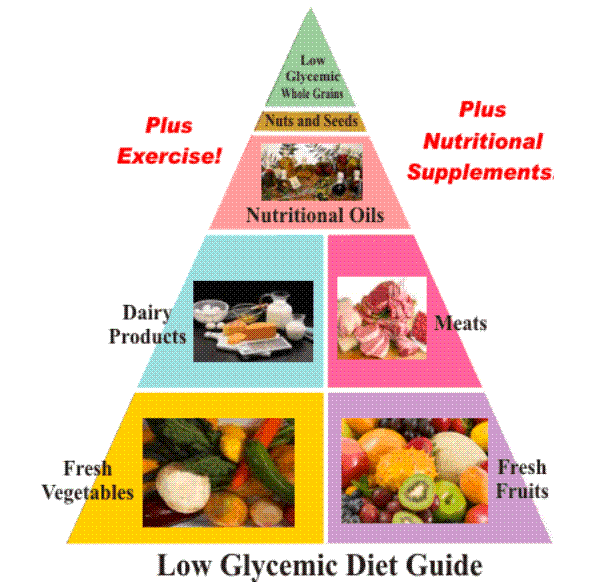
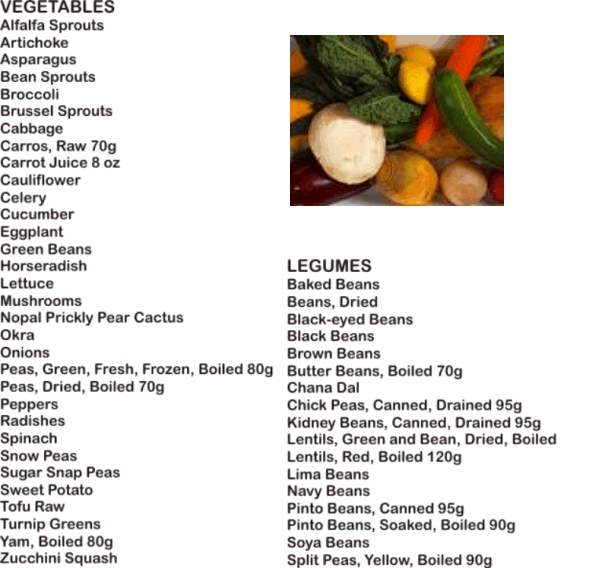
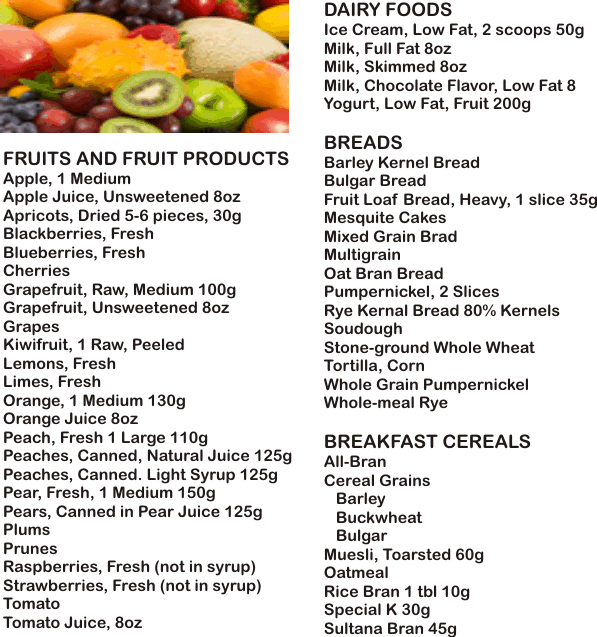
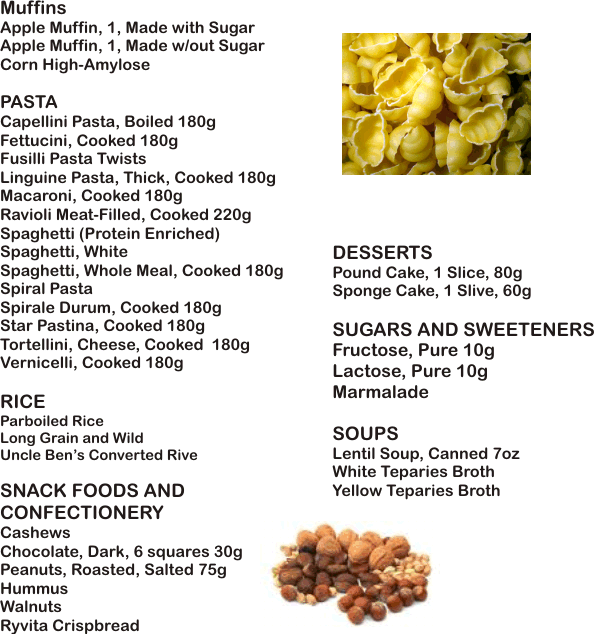
No Meat on the List!
 The Low Glycemic diet is a vegetarian diet. Meat is a luxury for people on this low
glycemic diet.
The Low Glycemic diet is a vegetarian diet. Meat is a luxury for people on this low
glycemic diet.
You may add some meat to this low glycemic diet to supplement your protein intake that you get from a vegetarian diet.
The choice is yours.
The pyramid includes meat; it is actually a chart for people who are following the Genetic Key Diet.
This is a diet that is based on an individual's DNA - their persosnal genetic type.
The above pyramid and the low glycemic diet form the latest diet-food index, which is based on an individual's genetic type. Depending on
your type, your diet will change to some degree.No two people are exactly the same; therefore, the diet will vary from person to person.
Two other diet pyramids have been used for many years:
The original USDA Low Fat Pyramid is very different from the above food pyramid and is completely wrong for many people. The USDA then came
up with a new USDA Low Fat Pyramid. It was better but still is incorrect for most body types.
Why is this food pyramid suitable for all genetic types?
Over the centuries all diets were determined by a person's actual body weight.
However, this is not a true index of what the person should weigh or how much weight they should lose.
All the old diet pyramids concentrated on getting rid of body fat, hence the low fat diets. However, this is a very big mistake.
Our bodies need some fat to survive.
Our muscles lose all their strength when too many fats are removed! So what is the answer? Some people need far more fats in their bodies
than others, depending on their genetic/metabolic type.
What does matter is "body mass", which is quite different than body fat! To diet correctly what the body needs to lose is INCHES,
not pounds.
A person could weigh 250 and be normal IF their body mass (or frame) was large enough to support it. A person with a small frame might be at a perfect weight at 125 or could be overweight, depending on body mass/metabolic type.
This method does not work for everyone but comes much closer to dealing with weight problems of all types then the old Low Fat diets that have been scientifically proven wrong.
Summary
When you follow the Genetic Pyramid System combined with Low Glycemic foods, you have an
excellent diet!
How much you weigh is not a true index of whether or not you are too heavy! What matters is
the inches in relation to your genetic body type: e.g., A muscular body-builder would weigh heavy but would not be fat!
Least in importance is the number of pounds that a person weighs! The inches matter, especially if a person is not a body-builder.
When you follow the Genetic Food Pyramid and the Low Glycemic Diet method of eating, you will lose inches.
However, some people actually gain weight; it is a healthy weight gain because that person is actually building muscle tone which is good.
Muscles weigh more than fat!
When you start using this system, be sure to measure yourself all over so that you can watch inches decrease instead of worrying about how
much weight has been lost.
If you want to learn more about it, I would recommend that you get the book, "The Genetic Key Diet" by Dr. Steve Nugent. He goes into great
technical detail about this entire subject and includes suggested recipes to get you started.
You need to add two more things the above "to do" list if you want to lose inches and keep them off.
1. Exercise...ugh, some of you may say! Well, without some exercise, the fat will settle and will become very difficult to get off!
It does not have to be hard, time-consuming exercise, but you need to walk or do a few short exercises at home during the day, something to
get your system moving!
2. Use proprietary supplements, minerals and vitamins to help your body in its task to keep you healthy and strong.
Food no longer has the nutrition in it that it used to have due to current farming methods, acid rain, picking foods before they are ripe.
These are just a few of the reasons that prevent our foods from being the nutritious fruits and vegetables that they used to be.
You need to supplement your diet for complete wellness.
Continue: Calculating Glycemic Load
Return to: Previous page
Return to: Top of article
|




 Core Technologies
Core Technologies
 Ambrotose®
Ambrotose®
 Ambrotose AO®
Ambrotose AO® MannaBears ®
MannaBears ® PhytoBurst™
PhytoBurst™
 NutriVerus™
NutriVerus™
 Optimal Support
Optimal Support PhytoMatrix®
PhytoMatrix®
 PLUS™
PLUS™
 BounceBack®
BounceBack®
 ImmunoStart®
ImmunoStart®
 MannaCLEANSE™
MannaCLEANSE™
 Optimal Support
Optimal Support Omega-3
Omega-3
 Uth™
Uth™
 new skin care
new skin care
 OsoLean®
OsoLean®
 GlycoSlim®
meal
GlycoSlim®
meal